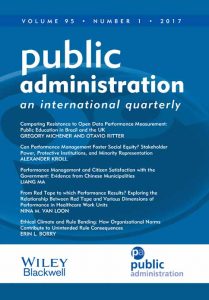Won’t somebody think of the children? Social democratic and neoliberal responses to ‘troubled families’ since 1945
When then Prime Minister David Cameron launched the Troubled Families Programme (TFP) in 2011 he claimed that ‘we’ve known for years that a relatively small number of families are the source of a large proportion of the problems in society’. He then outlined how his government would, in a radical new policy, ‘turn around’ the lives of the 120,000 so-called ‘troubles families’ by the end of the Parliamentary term.
It did not work. In its official evaluation, the TFP was found to have ‘no discernible impact’ on any of its own criteria for success. It was emphatically a waste of time and money. The full story of this failure has been told by Stephen Crossley in his book Troublemakers.
Although an embarrassing failure, the TFP was far from radical or new. A little cursory research would have revealed that the idea of ‘troubled families’ presented a disproportionate burden on the state has a pedigree. Historians John Welshman and Pat Starkey were quick to point out concern by post-war governments about ‘problem families’. The Director of the TFP and history graduate Dame Louise Casey did not learn these historical lessons.
The thinking behind ‘problem’ and ‘troubled’ families was very similar. Using the label as a broad umbrella, they both conflated multiple concerns as a problem or trouble of the family which repeated every generation. Poor school attendance and educational failure, unemployment and low wages, anti-social and criminal activities, use of welfare services and benefits, debt and financial difficulties, insecure housing and rent arrears, young mothers, alcohol or substance use, domestic violence and large families were used as signifiers which presented a problem – or trouble – to the state. Despite a focus on behavioural issues, both represented individualised solutions to structural experiences of poverty. It is hardly surprising then, as historian John Macnicol suggests, that there are uncanny similarities and continuities.
In my recent policy review for Children & Society, I look beyond the labelling similarities of ‘problem’ and ‘troubled’ families to consider how governments in the 1950s and the 2010s shaped policies which responded to the problem. Here, the family is central. Although Britain has never had a family policy as those which emerged elsewhere, it is clear that a focus on the family is pivotal in moving from theoretical labels to material practice.
Here, as John Welshman has commented, and expanded in his book Underclass, both ‘troubled’ and ‘problem’ families constitute part of a larger discourse of anxiety about an ‘underclass’. This extended back to the 1880s and Victorian fears of a ‘residuum’ or ‘submerged tenth’ through the 1930s and public disquiet about a ‘social problem group’ to the 1970s and a ‘cycle of deprivation’ right up to the present. However, concern in the 1950s and 2010s with problem or troubled families directly shaped governmental action, and moved beyond a generalizable discourse.
In line with behavioural interpretations of poverty, both ‘troubled’ and ‘problem’ family policies rested heavily on subjecting families to sustained intervention which brought them up to standard with wider society. Both advocated the use of a single keyworker or caseworker for each family, who would offer practical, friendly – but firm – advice and guidance to the family. This was in place of the phalanx – in Becky Taylor and Ben Rogaly’s words – of state services which were normally involved with families. These workers would ‘grip’ the family as a whole, rather than the different issues or service responses to family members.
Despite a common policy which targeted families through a single representative, there were different routes to action in the 1950s and the 2010s. Both represented cross-party political comments for action.
In the 1950s the impetus for action came from a variety of professional, organisational, governmental, expert and voluntary bodies which developed a common framework for action through consensus. A series of central government circulars provided guidance and direction on the formation of local ‘problem family’ committees which permitted a wide variety of interpretations: from restrictive and miserly to permissive and spendthrift ones. This was in character with post-war social democratic expectations of governance.
In the 2010s consensus was present, but it was imposed from the top. Although the TFP was rolled out in 2011, it has its antecedents in the Family Intervention Projects (FIPs) which were developed under New Labour’s Social Exclusion Unit. Louise Casey was common to both. Unlike the 1950s, the TFP imposed order from above, allocating numbers of families to be identified, mechanisms for measuring success on whether families had been ‘turned around’, and all strictly controlled through financial criteria. Despite commonalities, this was a form of neoliberal statecraft, as Stephen Crossley has identified.
There is, however, a chronological gap between the end of ‘problem family’ policies in 1974 and the emergence of ‘troubled families’ by 1997. The loose governmental oversight and professional discretion which could identify and target a ‘problem family’ did not last. Following a series of scandals where children had died at the hands of their family, most notably Maria Colwell in 1973, focus moved away from elastic notions of families and troubles to children, and the risk these same families represented to them. Historian Jenny Crane has exposed how competing claims to expertise reinvented family troubles or problems as indicators or potential harm or risk.
Ultimately these issues speak to a number of sociological concerns about families and parenting, the state and changing forms of governance, and professional power and expertise. At their heart is a behavioural response to structure inequality and material poverty; whether social democratic or neoliberal. However, although children and their welfare are integral to all the sociological issues and their political manifestation, their voice is notable by its absence, despite claims to speak on their behalf and act in their best interests. Won’t somebody listen to the children?
Read the full Open Access article published in Children & Society:
Lambert, M. (2019), Between “Families in Trouble” and “Children at Risk”: Historicising “Troubled Family” Policy in England since 1945. Child Soc, 33: 82-91. doi: 10.1111/chso.12309
Michael Lambert is a Research Associate in the Department of Public Health and Policy at the University of Liverpool.





1530-2415/asset/SPSSI_logo_small.jpg?v=1&s=703d32c0889a30426e5264b94ce9ad387c90c2e0)
